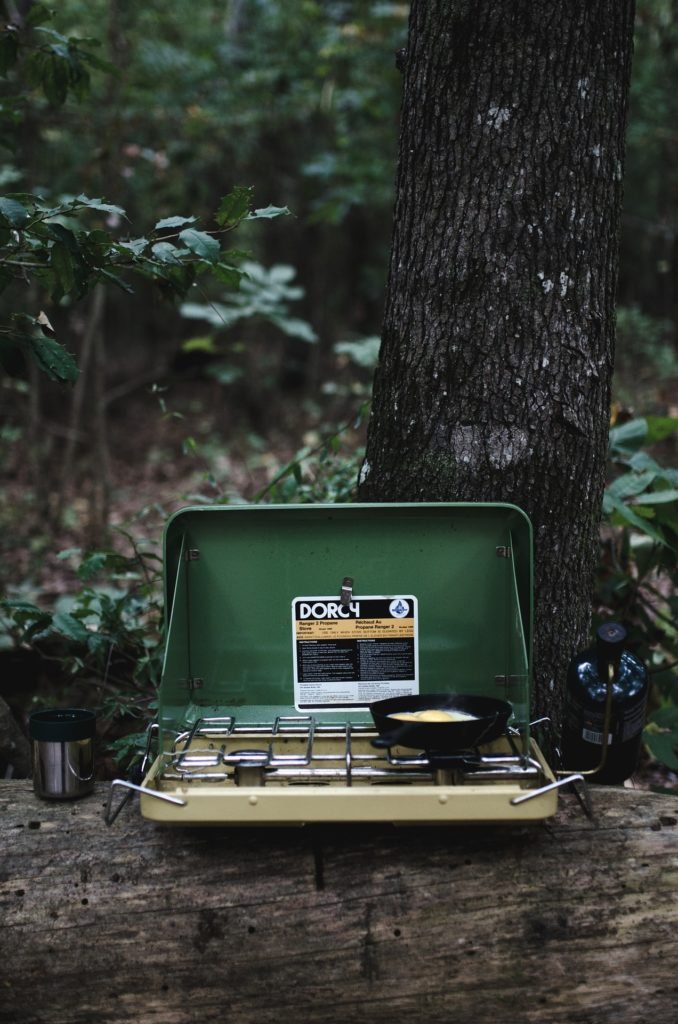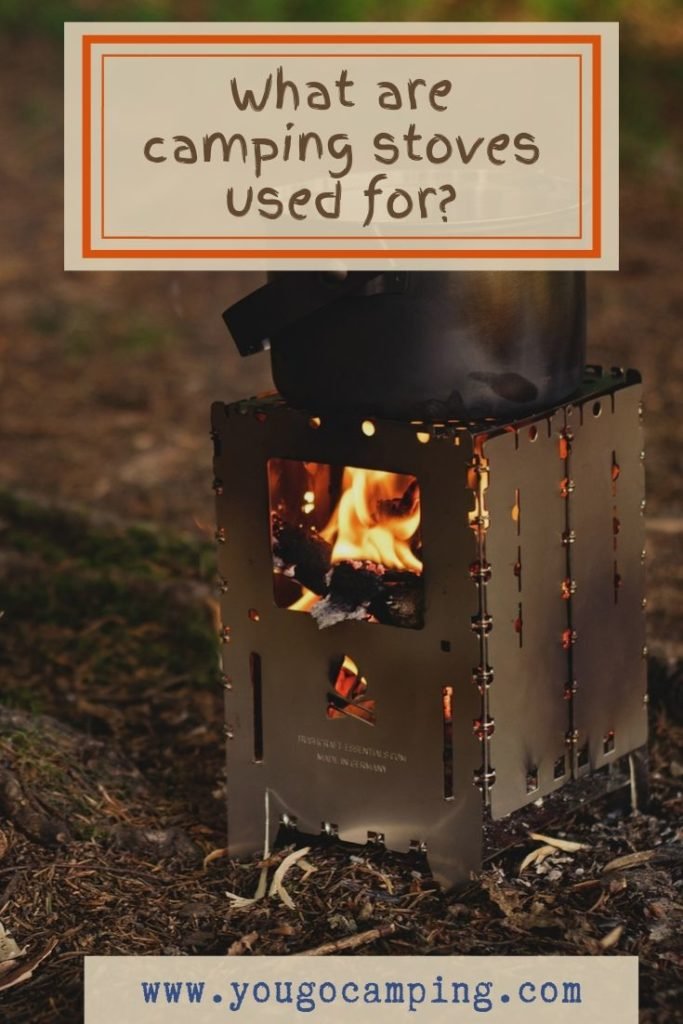Camping stoves are the central part of any camp. From tea to dinner, your stove will be your best friend. Sure, campfires are really pretty and can be fun, but most UK campsites don’t allow open fires. Campfires can also be more trouble than they’re worth to keep lit, especially in the rain or with damp fuel.
For the most part, camping stoves don’t have any of those problems. They’re fast, convenient, and can be used in most places and campsites.
Here are some of the things we use camping stoves for
- Coffee and Tea – a staple and vital use
- Breakfast
- Lunch
- Dinner
- Hot chocolate
- Hot water bottles
- Warming water for washing up, washing hair, general cleaning, and showers
Things you should use your camping stoves for:
Tea/Coffee in the morning
We have a camping kettle that makes two cups quite nicely. We boil the kettle and get settled in while sorting breakfast out. As Fee can’t function in the morning without at least two cups of coffee, it’s essential that the stove comes out. Niki usually wakes up to the sound of boiling water or ‘Tea!’.
There are many different sizes and makes of camping stove, but we’ve made tea and coffee on all of them, and that’s the most important thing we look for; does the kettle fit?
Bonus tip: when you’re making tea or coffee and using powdered milk, add a little warm water to the powder in a separate cup first before adding cold water to make it into milk. This prevents lumpy milk in your tea. there’s usually a spare cup or bowl hanging around to do this with so you don’t have to go milk-first in your tea!

Making breakfast
Breakfast is the most important meal of the day! Especially when camping. Depending on your activities, you want to have something substantial, filling, and calorie-dense. We either have a good pot of porridge or a fry up.
Breakfast burritos with hot dogs, potatoes and eggs are a firm favourite. These can be made in one pot, saving tie, gas, and most importantly: washing up.
Making lunch
If we’re at camp for lunch, we usually go for soup and sandwiches with a cup of tea. At this point, it’s usually a good idea to use the leftover warm water to do a bit of washing up with.
Incidentally, if anyone knows of a camping dishwasher, we’d love to test it out. It has to be our least-favourite task!
Making dinner
Our dinners usually consist of either MRE (Meals Ready to Eat) type meals that need reheating, or precooked rice (in a packet, or dried style) and a tin of something nice (chilli, chicken in white sauce, curry etc). We like a nice quick and easy, yet hot and filling dinner.
Camping and fresh air make everyone hungry, so a good filling dinner is just the ticket.
Sometimes we will go a bit more adventurous and go for something a bit longer, but most of the time your standard one-pot meal with a carbohydrate like pasta or rice is the best place to start. If you are lucky enough to be working with a campfire, you have many more options for food!
Get some inspiration and a sample menu for your next 3 day trip with this post!
Tea/hot chocolate at bedtime
Under the stars, a nice hot cup of tea or hot chocolate is the perfect way to round off a day. It warms your body up and relaxes you ready for a good night’s sleep. A warm drink can help to warm your core up on a cold night camping too, keeping you warmer for a little longer.
Hot water for the chilly nights
We do like to carry small hot water bottles for chilly nights. So we tend to boil the kettle one last time before bed to fill them up.
Tip: Don’t go to bed with the hot water bottle, put it in your sleeping bag while you get changed. It’ll warm up more of your sleeping bag. Put your hot water bottle between your thighs or hug it to your chest for maximum warmth.
Hot water for washing
When it’s muddy and damp, a nice little wash with hot water can really lift your spirits. A nice little wipe over with a hot cloth can really refresh you. Keep clean when camping! Always wash off the day’s dirt. Otherwise, a small cut or graze can turn into something nastier.
We’ve also used a bowl of warm water for hair-washing, filling up a DIY shower (or a solar shower if it’s been an overcast day) and for general cleaning of tough dried on mud on our gear. Just be aware that some of your gear can’t take hot water and shouldn’t come into contact with it.
Things you should NOT use your camping stove for

As with almost all camping gear, there’s a right way and a wrong way to use it. With a camping stove, this is even more prevalent. Most camping stoves use gas or a flammable fuel, and all will produce a flame. It almost goes without saying that fire is hot and potentially dangerous.
Here is a list of things NOT to use your camping stove for.
Keeping lit for light/heat
We see people doing this a lot. It’s a waste of gas/fuel and can cause your stove to overheat. Wrap up warm when sitting outside or fill a hot water bottle.
As well as wasting gas, a naked flame in camp is always a risk – the wind could blow it over, a misplaced step could knock it over.
Keep safe, only have the stove lit for the minimum amount of time required. Make sure it is out fully, gas disconnected and any solid fuel spent when you’re finished.
Whilst campfires can continue to burn down for a long time and keep you warm, if you are finished with your fire for the night you must make sure it can burn out on its own or it’s fully out. Do not leave fuel (wood/paper/synthetics/plastic) within reach of a spark. Ensure it is fully out before you leave your camp for any length of time and before you go home.
Find better ways to warm yourself up on a chilly night with this article.
Tent warming
No, just no.
There are no gas camping stoves or solid/alcohol fuel stoves that are safe to put inside a tent. Ever. Use a hot water bottle and wrap up in layers. Never, ever take a stove inside your tent.
NEVER, EVER put any kind of open flame in a standard tent. There are tents that are made specifically to have a stove in, but 99% of tents are not. They will melt, they will burn.
There are a number of campers who die every year from carbon monoxide poisoning because they bring a portable barbecue into their tent to keep it warm while they sleep. Don’t be a statistic. Don’t take any kind of flame into your tent, that includes gas stoves, candles, solid fuel stoves, and alcohol stoves.
Camping Stove safety:
- Most camping stoves are gas based -DO NOT let your gas sit in full sun. There is the chance that the cannister could explode.
- Exploding gas is hot and dangerous – Be aware of how close your gas cannisters are to any heat source. Check the temperature of the gas cannisters. Gas cannisters usually feel cold. If your cannister feels warm, move it away from the heat immediately.
- Do not take risks with gas – It’s hot and dangerous. Use it only for its intended purpose.
- DO NOT leave gas your car during a summer’s day– We tuck our cannisters under the edge of a tent to keep them slightly cooler during the day.
- DO NOT allow children to use gas camping stoves or cannisters without full supervision – We have sadly seen the result of a child using a gas camping stove next to an open fire. It didn’t look or sound pleasant. The scream of that child still haunts us. Please, please, do not let your children play with fire or use gas or gas stoves unless they are being closely supervised.
- Make sure that your stove is actually out before leaving it – Some are very quiet and you may think that the flame is out, but make sure.
- Don’t pack down a hot stove – Many stoves come with a plastic packing box. Plastic will melt if the stove is hot. Leave your stove to cool before putting it away. If you’re not putting it in a plastic box, remember that tents are made of plastic materials and will also melt if anything hot is put on the groundsheet. You don’t want to put your stove in a tent and come back to find a hole or a pile of ash where your tent and sleeping stuff used to be.
- Remove gas from stoves that are not in use – If there is a small leak or the seal is not as good as it once was, you really don’t want gas leaking into your tent.
- If using solid fuel, only use a small amount at a time – As convenient as it is, solid fuel can be unpredictable and the small flame that looks disappointing when you want a cup of tea can soon become a raging fire. Start with one tablet and add (no more than 3 small tabs, 1 large one). We’d recommend keeping a piece of wet rag or a damp teatowel nearby if you’re using solid fuel as it’s the quickest way to smother a solid-fuel fire. Never pour water directly onto flaming solid fuel. Rag first, then water.
- Remember that anything you’ve cooked or cooked with is going to be hot! – You wouldn’t believe the number of times we’ve seen people burn themselves on cooking equipment because they assume it’s not going to be hot because it’s not a stove at home.
- In the same vein, boiling water is boiling water – Whether it’s from the kettle at home, the saucepan on the hob, or on the camp stove. It’s going to be hot, and it will scald. Take the same precautions with a camp stove that you would with the hob at home. Keep it out of reach of small children and animals and supervise at all times.
Fire precautions
Fire precautions – We have to admit to being too relaxed on this one, until we saw what happens when you are careless with fire.
Don’t spare the extra weight, pack at the minimum a bucket (even a foldable one) and fill with water. Keep it near your tent and fire.
If you’re car camping, go the extra mile and pack a proper bucket (even a collapsible one), a fire extinguisher (powder is best), and a fire blanket. It seems excessive until you’ve seen a tent fire or witnessed fire-related injuries.

If the worst is to happen, and a stray spark lands on a person, put it out immediately. Remember: STOP, DROP and ROLL.
For more information on fire safety, check out this link.
Did you find this helpful? What do you use your stove for? Let us know in the comments.



0 Comments